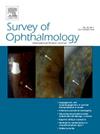Trabecular meshwork: A pivotal target for evolving glaucoma treatments
IF 5.9
2区 医学
Q1 OPHTHALMOLOGY
引用次数: 0
Abstract
The trabecular meshwork (TM) is a key regulator of intraocular pressure (IOP) through its role in facilitating aqueous humor outflow. Pathological alterations in the TM—such as reduced cellularity, impaired extracellular matrix turnover, and increased biomechanical stiffness—raise outflow resistance, leading to elevated IOP and contributing to glaucoma pathogenesis. We summarize the TM’s anatomical structure, cellular heterogeneity, and biomechanical properties, emphasizing its central role in maintaining IOP homeostasis. It also outlines TM alterations across different glaucoma subtypes and highlights key molecular mechanisms underlying TM dysfunction, including dysregulation of Rho GTPase signaling, nitric oxide (NO) pathways, TGF-β2-induced fibrosis, lipid signaling, and endoplasmic reticulum stress. Advancements in TM-targeted therapies include pharmacologic interventions (e.g., Rho kinase inhibitors, NO donors), non-invasive approaches (e.g., laser trabeculoplasty, ultrasound, sonic therapies), and minimally invasive glaucoma surgeries. Emerging gene therapies that target TM outflow pathway show promise for long-lasting IOP control. Additionally, cell-based therapies aiming to restore TM cellularity and function represent a novel regenerative strategy. Despite significant progress, challenges remain in optimizing delivery methods, sustaining therapeutic efficacy, and ensuring safety. We highlight the evolving landscape of TM-targeted interventions and underscore the importance of continued innovation in glaucoma management.
小梁网:青光眼治疗的关键靶点。
小梁网(TM)通过其促进房水流出的作用是眼内压(IOP)的关键调节因子。tm的病理改变,如细胞减少、细胞外基质转换受损和生物力学刚度增加,会增加流出阻力,导致IOP升高,并促进青光眼的发病。我们总结了TM的解剖结构、细胞异质性和生物力学特性,强调了其在维持IOP稳态中的核心作用。它还概述了不同青光眼亚型的TM改变,并强调了TM功能障碍的关键分子机制,包括Rho GTPase信号、一氧化氮(NO)途径、TGF-β2诱导的纤维化、脂质信号和内质网应激的失调。tm靶向治疗的进展包括药物干预(例如,Rho激酶抑制剂,NO供体),非侵入性方法(例如,激光小梁成形术,超声,超声治疗)和微创青光眼手术。针对TM流出途径的新兴基因疗法有望长期控制IOP。此外,旨在恢复TM细胞结构和功能的细胞疗法代表了一种新的再生策略。尽管取得了重大进展,但在优化给药方法、维持治疗效果和确保安全性方面仍然存在挑战。我们强调了以tm为目标的干预措施的发展前景,并强调了青光眼管理中持续创新的重要性。
本文章由计算机程序翻译,如有差异,请以英文原文为准。
求助全文
约1分钟内获得全文
求助全文
来源期刊

Survey of ophthalmology
医学-眼科学
CiteScore
10.30
自引率
2.00%
发文量
138
审稿时长
14.8 weeks
期刊介绍:
Survey of Ophthalmology is a clinically oriented review journal designed to keep ophthalmologists up to date. Comprehensive major review articles, written by experts and stringently refereed, integrate the literature on subjects selected for their clinical importance. Survey also includes feature articles, section reviews, book reviews, and abstracts.
 求助内容:
求助内容: 应助结果提醒方式:
应助结果提醒方式:


